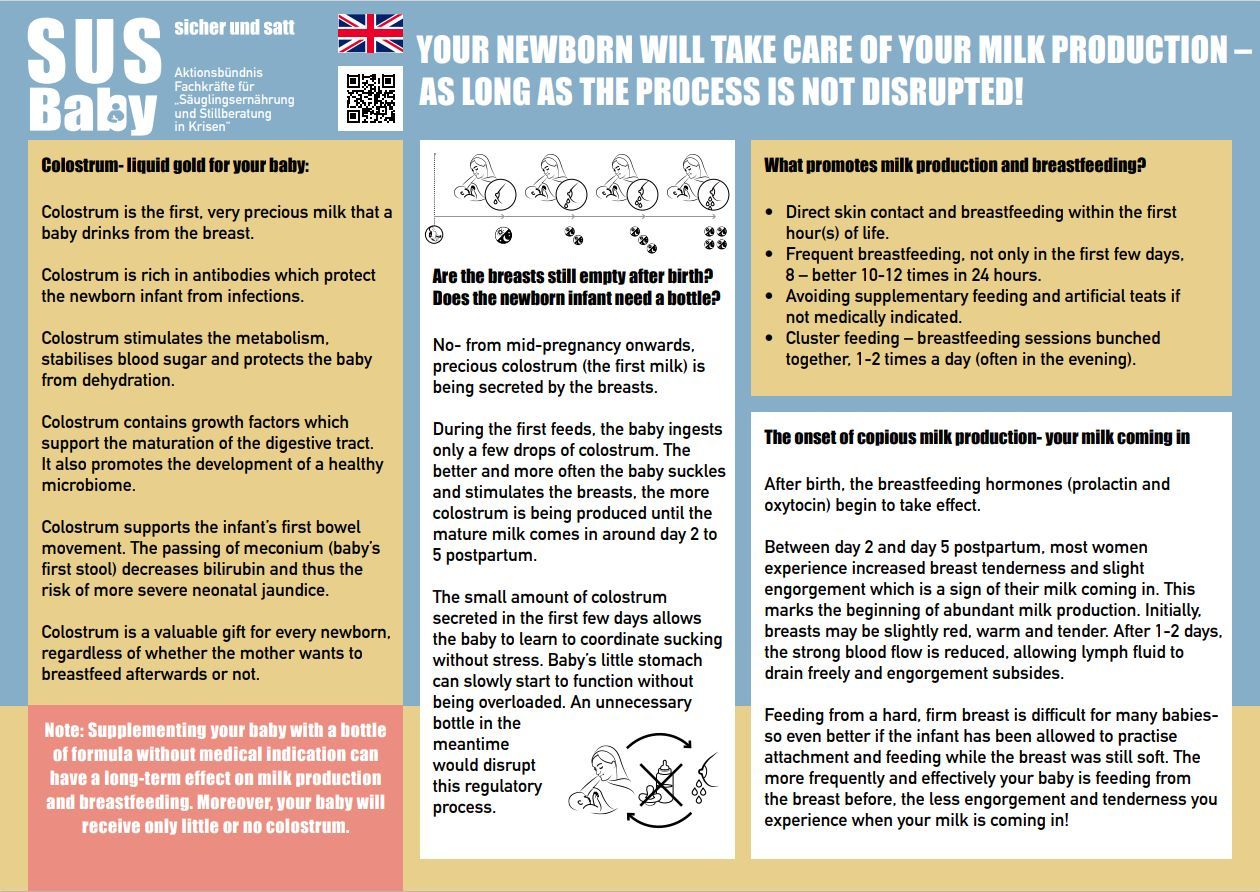Infant and young child nutrition in crisis situations or disasters
In emergencies such as war, flight, natural or technical disasters, infants and young children are particularly at risk of malnutrition, illness and death. They are highly dependent on their caregivers, their immune systems are still developing, and their bodies and brains rely on nutrition for healthy growth and development. The safest, easiest, and cheapest diet readily available in such circumstances is breastfeeding.
- Infants and children under the age of 2 are particularly vulnerable in emergency situations.
- What worked at home - for you or the refugees - may not be safe in emergency situations. Try not to let your personal experiences influence you.
- Breastfeeding saves lives in emergencies. Mothers need to be encouraged and supported to continue breastfeeding until the child is 2 years old.
- Stress, exhaustion, illness and dehydration do NOT stop a mother's milk supply, but they can make her feel like it is. Stress can at least temporarily inhibit the milk ejection reflex. Encourage mothers to continue breastfeeding, frequent nursing will reverse the negative effect of stress.
- If a mother is partially breastfeeding or has stopped breastfeeding within the last 2 weeks, she should be encouraged to return to breastfeeding by breastfeeding her infant frequently, ie 2-3 times per hour and supplementing infant formula AFTER breastfeeding if necessary .
- Babies under 6 months need breast milk or formula milk.
- Babies over 6 months (if they are not breastfed) can be fed with complementary foods and whole animal milk (cow´s or goat's milk). Follow-on milk is unnecessary.
- Please note that mothers who have fled to a safe third country are still in a particularly stressful situation and that breastfeeding should also be prioritized in this case.
Key questions and key phrases for infant and young child nutrition assessment and support
These key questions are formulated in English - Ukrainian and Russian
Start breastfeeding earlier in emergencies
Starting exclusive breastfeeding early saves lives. It should be a priority in humanitarian responses for both healthy and vulnerable newborns. Below is a list of specific care scenarios and advice for healthcare workers.
Note information material in different languages on the sub-page "Parents and carers", "Skin to skin contact for a successful start to breastfeeding" and "Breastfeeding – cheap, safe food during a crisis"
Information posters on the early start of breastfeeding for migrant women on the maternity ward

You can currently download these posters in 12 different languages or order the PDF in print quality free of charge.
You will find the poster under "Parents and caregivers" under the heading "Your newborn provides milk production - Important information for the first few days after birth.
The following languages are currently available:
German, English, French, Spanish, Portuguese, Russian, Turkish, Arabic, Albanian, Czech, Polish and Dutch.
Other languages are still being worked on.
Infant feeding in acute crisis situations
Brief information on the topic of infant feeding in acute crisis situations with a triage approach for decision-making on the feeding of infants under 6 months.
Dealing with artificial baby food in crisis situations
Infants and young children fed with formula are at high risk of malnutrition, illness and death in a crisis situation. Act immediately to protect children and to support their mothers and other caregivers to minimize risk and meet the nutritional needs of their infants.
Donations and uncontrolled distributions of infant formula lead directly to a decrease in breastfeeding, to an increase in feeding with infant formula and endanger the baby.
Infant feeding during infectious disease outbreaks
In any emergency - including infectious diseases - outbreaks e.g. Ebola, Cholera, COVID-19 - it is important to assess the nutritional needs of infants and young children and to protect both breastfed and non-breastfed children.
Infant and young child feeding in the first three days after a nuclear power plant accident
The recommendations are based on the best available knowledge and full consideration of the risks associated with internal contamination by radioactive materials in the first three days after an incident at an NPP as well as the importance of breastfeeding. The recommendations of other organisations may focus primarily on the risk of exposure to radioactive materials without fully balancing the risks of morbidity and mortality associated with not breastfeeding. This guidance should be used in conjunction with existing guidance for the general public, healthcare workers and policy makers.
Infant and Young Child Feeding in the Context of a Biological Attack
The following guidance note serves to outline key facts on IYCF in the context of a biological attack, including management and treatment, and recommendations for breastfeeding and infant feeding. The guidance note is intended for policymakers and for people who will provide guidance for health facilities and healthcare workers in the case of a biological attack.
Infant and Young Child Feeding in the Context of a Chemical Attack
The purpose of this Guideline is to outline key facts on IYCF in the context of a biological weapon emergency to inform emergency plans and responses. The guidance note is intended for policymakers and for people who will provide guidance for health facilities in the case of a chemical agent attack. There are a wide variety of possible agents that can be used in a chemical attack and therefore this guidance note will prioritise those most likely to be used, describing how IYCF could be impacted.
Operational Guide to Infant and Young Child Feeding in Disasters
The goal of the OG-IFE is to provide concise, practical guidance on how to ensure adequate infant and young child nutrition in emergencies.
The document is aimed at policy makers, and programmers working in emergencies
Preparedness and response, including governments, United Nations (UN) agencies, national and
international non-governmental organizations (NGOs), donors, volunteer groups and the
private/commercial area.




















